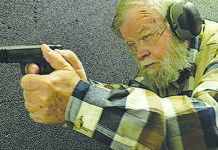One of the ongoing arguments between wingshooters is the 12 vs. 20 discussion. The short version of that issue can be summed up in two questions: Can I get away with the smaller gauge for the shooting I do?, or, Do I need the deeper and wider shotshell selection that the 12 gauge offers? One of the major reasons hunters choose a 20 over a 12 is the former’s smaller frame, weight, and recoil. Though they may already own a 12, many field sportsmen wind up reaching for their 20s because the smaller gun is easier to handle, and there are just a few situations—layback goose hunting and spring turkey hunting, to name two—in which the bigger 12-gauge payload might make a difference.
Based solely on ballistics, it’s tough to make a case that the 20 gauge can’t do most or all of the jobs the 12 gauge does. But that’s not the whole story. There are certainly restrictions based on the 3-inch guns available for the two gauges. Looking at the major shotgun lines, Remington puts 3-inch chambers for both gauges its 11-87 Sportsman, Sportsman Camo, and Sportsman Synthetic lines, but it also doesn’t chamber 20 gauges at all in its specialty guns for turkey, deer, and waterfowl, and some of the other 11-87s. Mossberg shunts its three 20-gauge models into the SA-20 line, offering no 20s in the 935 or 930 lines. In its vast selection of semiautos, Beretta offers just the AL391 Teknys Gold Sporting, AL391 Urika 2 Youth X-Tra Grain, and the 3901 Citizen Synthetic in 20 gauge. Available shotshell loads, too, show an overwhelming preference for the 12 gauge. Picking just one company to sample, Federal offers 65 12-gauge loads in its inventory, but only 21 20-gauge shot loads, a 3-to-1 edge.
So, even before we get rolling, the discussion of picking a 20 over a 12 for all-round use doesn’t get much traction; there are just not enough 20-gauge shotguns and 20-gauge loads to make a 20 practical for use from woodcocks and snipe to Canadas and Merriams. But if we recast the argument to make it an upland comparison, then suddenly the playing field evens out.
Toward that end, Gun Tests Magazine found a lightweight low-cost polymer-stocked shotgun from Escort to schlep around North Dakota to shoot pheasants. The test gun was the LSI/Hatsan Escort PS-20 HAT00115 3-inch 20 Gauge, $399 (price from Gallery of Guns online store).
Here’s what they said:
The Escort Magnum 20-bore we tested was made in Izmir, Turkey (about 200 miles southwest of Istanbul) by the Hatsan Arms Company and imported by Legacy Sports International of Reno, Nevada. LSI supplies a five-year warranty for the Escorts it imports.
Our test gun came with nickel-chrome-moly 26-inch barrels with a hard-chrome-plated bore and outside black chrome finish. The ventilated barrel rib was scored with C-shaped grooves along most of its length as a glare-killer, and the muzzle was threaded to accept screw-in choke tubes, and three (Full, Modified, and Improved Cylinder) came with the gun. Of course, the 3-inch magnum chamber and choke tubes were proofed for steel shot, and all sporting Escorts include sling-swivel studs, a choke-tube wrench, and migratory waterfowl plug. For a working gun, the studs were a helpful addition.
Examining the black-anodized aircraft-alloy receiver, we noted a trigger-guard button safety and a big grooved cut-off button for loading single rounds. Milled into the top of the Escort’s receiver was a 3⁄8-inch dovetail rib for accessory sights. The gas-operated semiauto came with two stock-adjustment shims and three cushioned rubber recoil pads in what the company calls small, medium, and large girths. The Smart Valve Piston gas system is rated for 7⁄8-oz. to 2-oz. magnum shotloads, and didn’t require changing valves to operate.
At just 6.25 pounds and 46 inches OAL, the gun weighs about right for a single-barrel 20 gauge that you carry in one hand while jogging behind pointing dogs, and the action and magazine tube contribute about 4 pounds of that total, or more than 40% of the gun’s total weight. The point of balance fell in line with the front edge of the aluminum alloy receiver. The Escort’s stock and fore-end were polymer, meaning they are strong, light, waterproof, and oilproof. The molded grip panels substituted for checkering and were very effective, our team said. The slender fore-end felt easy to hold and was long enough to accommodate both short- and long-leading-arm shooting styles. The as-delivered 14.25-inch LOP measured short for most shooters, but it was adjustable by replacing the buttpad. The drop at the tip of the comb and heel of the right-handed stock measured 1.5 inches and 2.5 inches respectively, but they can be altered by the addition of drop spacers used either singly or as a pair. Our team said this gave the Escort a big edge.
The 26-inch Escort barrel accepts 3-inch magnums, and we shot as little of them as we could, because those shells caused stiff recoil in the light gun. Slim and gently tapered, the 6mm-wide ventilated top-rib ended with a greenish light sight instead of a brass front bead. We found the green-plastic bead was easier to see in dingy light. Inside the gun, the bore was clean and well finished, and the breech extension was smooth.
Some of our shooters used to over/unders complained about the safeties on the gun—buttons near the trigger guard—as not feeling as natural as a tang safety.
Disassembly was uneventful. Before disassembling the shotgun, always make sure that the shotgun is not loaded, the barrel is pointed in a safe direction and the safety is On. With the bolt in the forward position unscrew (counter-clockwise) the fore-end cap. Remove the fore-end cap and from the magazine tube. Grasp the barrel and remove it from the stock-receiver-magazine tube assembly. With your fingers compress the bolt to align the two notches on the bolt where the cocking handle is attached. Then with your other hand pull the bolt cocking handle and remove it from the bolt. Remove the rubber ‘O’ ring and gas piston out of the magazine tube by sliding them. Slide the bolt and the action bar forward and remove them from the magazine tube-receiver assembly. At this point, keep the bolt up to prevent it from falling away from the action bar. Reassembly in reverse is straightforward.
If you want to keep going and remove the trigger assembly, first punch the two pins out with a hammer, then press the carrier downward until the trigger assembly moves down, and then pull the trigger assembly downward using the trigger guard to remove it completely. If you want to take just the trigger assembly out, it can be done without first removing the barrel or bolt assembly.
There are five different screw-in chokes that can be used in the shotgun, but only three come as standard equipment. The tube body is labeled with the constriction, and the front edges are notched to designate their choke status (Full / ), (Modified /// ), (Improved Cylinder //// ). In both guns, the Modified and Improved Cylinder are good for steel shot. The Full Choke tube should be used with only lead shot. We shot and got IC-rated shot densities on Hunter John patterning targets, which we shot at 25 yards to try to counteract a stiff right-to-left wind. To no avail, because the gun’s patterns strongly shifted to the left.
One of the few complaints we had with the gun was the stockfit as delivered. But through a trial-and-error process, each shooter used the three buttpads and two stock shims to pretty much get the stockfit he wanted. To do that, we unscrewed the very tight buttplate screws and removed the recoil pad. To continue disassembly, then turn the nut in the hole in which the stock-connecting rod extends by means of a box spanner, and remove the stock connecting nut, spring washer, and the washer. Then, remove the stock from the stock connection rod. Assemble the stock drop spacer(s) and put the stock over the stock connection rod. Reassemble the stock-connecting nut, spring washer, and the washer. Then screw the buttplate screws to the end until the stock completely seats in its place.
Our Team Said: In this budget polymer-stock matchup, the Escort did one thing much better than other similar guns we tested. It also had several features lacking on the others, such as sling swivels, a receiver milled to accept accessories, and a shim-adjustable stock. We’ve tested several guns selling for a heckuva lot more that didn’t include those amenities. Any way you shake it, for upland use this gun from Turkey ain’t no turkey.























very good write up on this gun,helped me alot to get a review before buying this gun,seems to be a good upland gun for dove,woodcock and quail.also squirrel and rabbit.thank you for the review.